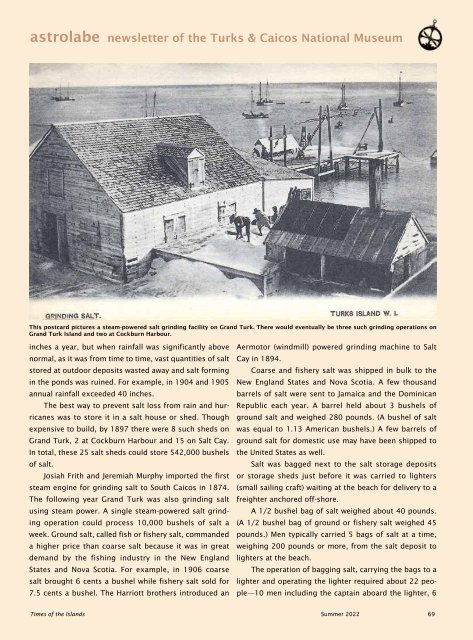Times of the Islands Summer 2022
Presents the "soul of the Turks & Caicos Islands" with in-depth features about local people, culture, history, environment, real estate, businesses, resorts, restaurants and activities.
Presents the "soul of the Turks & Caicos Islands" with in-depth features about local people, culture, history, environment, real estate, businesses, resorts, restaurants and activities.
Create successful ePaper yourself
Turn your PDF publications into a flip-book with our unique Google optimized e-Paper software.
astrolabe newsletter <strong>of</strong> <strong>the</strong> Turks & Caicos National Museum<br />
This postcard pictures a steam-powered salt grinding facility on Grand Turk. There would eventually be three such grinding operations on<br />
Grand Turk Island and two at Cockburn Harbour.<br />
inches a year, but when rainfall was significantly above<br />
normal, as it was from time to time, vast quantities <strong>of</strong> salt<br />
stored at outdoor deposits wasted away and salt forming<br />
in <strong>the</strong> ponds was ruined. For example, in 1904 and 1905<br />
annual rainfall exceeded 40 inches.<br />
The best way to prevent salt loss from rain and hurricanes<br />
was to store it in a salt house or shed. Though<br />
expensive to build, by 1897 <strong>the</strong>re were 8 such sheds on<br />
Grand Turk, 2 at Cockburn Harbour and 15 on Salt Cay.<br />
In total, <strong>the</strong>se 25 salt sheds could store 542,000 bushels<br />
<strong>of</strong> salt.<br />
Josiah Frith and Jeremiah Murphy imported <strong>the</strong> first<br />
steam engine for grinding salt to South Caicos in 1874.<br />
The following year Grand Turk was also grinding salt<br />
using steam power. A single steam-powered salt grinding<br />
operation could process 10,000 bushels <strong>of</strong> salt a<br />
week. Ground salt, called fish or fishery salt, commanded<br />
a higher price than coarse salt because it was in great<br />
demand by <strong>the</strong> fishing industry in <strong>the</strong> New England<br />
States and Nova Scotia. For example, in 1906 coarse<br />
salt brought 6 cents a bushel while fishery salt sold for<br />
7.5 cents a bushel. The Harriott bro<strong>the</strong>rs introduced an<br />
Aermotor (windmill) powered grinding machine to Salt<br />
Cay in 1894.<br />
Coarse and fishery salt was shipped in bulk to <strong>the</strong><br />
New England States and Nova Scotia. A few thousand<br />
barrels <strong>of</strong> salt were sent to Jamaica and <strong>the</strong> Dominican<br />
Republic each year. A barrel held about 3 bushels <strong>of</strong><br />
ground salt and weighed 280 pounds. (A bushel <strong>of</strong> salt<br />
was equal to 1.13 American bushels.) A few barrels <strong>of</strong><br />
ground salt for domestic use may have been shipped to<br />
<strong>the</strong> United States as well.<br />
Salt was bagged next to <strong>the</strong> salt storage deposits<br />
or storage sheds just before it was carried to lighters<br />
(small sailing craft) waiting at <strong>the</strong> beach for delivery to a<br />
freighter anchored <strong>of</strong>f-shore.<br />
A 1/2 bushel bag <strong>of</strong> salt weighed about 40 pounds.<br />
(A 1/2 bushel bag <strong>of</strong> ground or fishery salt weighed 45<br />
pounds.) Men typically carried 5 bags <strong>of</strong> salt at a time,<br />
weighing 200 pounds or more, from <strong>the</strong> salt deposit to<br />
lighters at <strong>the</strong> beach.<br />
The operation <strong>of</strong> bagging salt, carrying <strong>the</strong> bags to a<br />
lighter and operating <strong>the</strong> lighter required about 22 people—10<br />
men including <strong>the</strong> captain aboard <strong>the</strong> lighter, 6<br />
<strong>Times</strong> <strong>of</strong> <strong>the</strong> <strong>Islands</strong> <strong>Summer</strong> <strong>2022</strong> 69
















